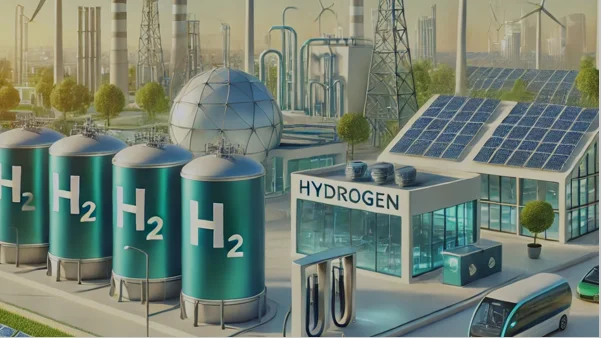Green Hydrogen Production: The Future of Clean Energy Revolution
Solar panels and wind turbines have long represented the transition to clean energy. However, green hydrogen production is emerging as a significant component in this evolving landscape.
Green Hydrogen: Powering India’s Clean Energy Future Beyond Sun and Wind
Solar panels and wind turbines have long represented the transition to clean energy. However, green hydrogen production is emerging as a significant component in this evolving landscape. Though its origins may seem technical, its potential is increasingly recognized within the clean energy narrative. This is particularly relevant for nations like India, where the demand for sustainable and dependable power steadily increases.
What Is Green Hydrogen and Why Does It Matter?
We know the sun doesn’t shine 24/7, and the wind doesn’t always blow when we need it. That’s one of the big problems with renewable energy. It’s not always there when you want it. That’s where green hydrogen steps in. It gives us a way to store energy. Not for just a few hours like a battery, but for days, weeks, even months. This changes the game completely. You’re no longer tied to real-time weather patterns or stuck wasting electricity you can’t use right away.
So, what exactly is green hydrogen?
To put it simply, it’s hydrogen gas made using clean electricity like solar or wind power to split water into hydrogen and oxygen. This process, called electrolysis, doesn’t produce any carbon dioxide if the electricity comes from renewable sources. That’s what makes it “green.” The hydrogen produced can then be stored and used later as fuel or turned back into electricity when needed.
This isn’t just a theory anymore. It’s happening. In fact, projects are already being tested and built around the world and in India. But before we get into that, it’s worth taking a closer look at how green hydrogen production actually works.
How Green Hydrogen Production Works?
It all begins with clean electricity. You take that electricity and run it through an electrolyzer, which is a device that breaks water into its basic components – hydrogen and oxygen. The hydrogen is captured and stored, while the oxygen is released into the air or used for something else. There are different kinds of electrolyzers out there. Some are older and cheaper but slower. Others are faster and better suited to match the ups and downs of renewable energy. A few are still being tested in labs and are not ready for large-scale use.
Hydrogen is so useful because it doesn’t just sit there doing nothing. It can be used in so many ways. You can burn it to create heat. You can feed it into a fuel cell to generate electricity. You can even use it to run vehicles. Unlike solar or wind power, which mostly generate electricity, hydrogen gives you the flexibility to do more. That’s a big deal when you think about industries that need high temperatures, like steel or cement production, or trucks that drive long distances where charging a battery isn’t practical.
Why Should India Focus on Green Hydrogen?
When we think about India’s energy future, flexibility matters. The country has some of the best solar and wind resources in the world. But without a good way to store that energy, much of it goes to waste. By turning excess electricity into hydrogen, we don’t just solve a storage problem; we create a clean fuel that can be used all across the economy.
Think of a state like Rajasthan, for example. It gets more sunlight than it knows what to do with. Imagine if some extra power could be turned into hydrogen during the day and then used to power factories at night or stored for weeks when needed. Suddenly, you’re not just generating clean energy. You’re keeping it around and using it on your terms.
India’s government is already working on making this happen. Several plans are designed to bring down the cost of green hydrogen and push adoption across sectors. They’re looking at ways to support research, build infrastructure, and encourage private companies to get involved.
The Cost Factor and What It Means for Adoption
Right now, making green hydrogen is more expensive than using fossil fuels or even making grey hydrogen, which is produced from natural gas and emits carbon dioxide. A kilo of green hydrogen in India can cost anywhere between INR 350 to INR 500, while grey hydrogen might cost closer to INR 150 or so. That’s a big gap. But just like solar panels used to be expensive and are now everywhere, hydrogen costs are expected to drop as the technology scales up.
Technology and Infrastructure are Still Catching Up
Infrastructure is another issue. You can’t just plug hydrogen into your existing energy system. You need new pipelines, storage tanks, safety systems, and training. Since hydrogen is a flammable gas, you also need to make sure it’s handled properly. But we already handle other fuels like LPG and petrol safely, so it’s just a matter of building the right setup and following safety rules.
The big picture here is that hydrogen doesn’t replace solar or wind – it works with them. It takes the clean electricity we already produce and makes it even more valuable. You’re not just using it right away. You’re holding on to it, turning it into something that can run a factory, fuel a bus, or provide backup power during outages.
Where Green Hydrogen Can Make the Biggest Impact?
Some of the most promising uses for green hydrogen are in places where other clean options fall short. Heavy trucks, for example, need long driving ranges and quick refueling, something batteries still struggle with. Steel factories need intense heat around the clock, and switching to electric furnaces isn’t always easy. Green hydrogen can solve both problems.
Conclusion
We’re at the beginning of a long journey, but things are moving fast. Governments, companies, and researchers are all working together to bring hydrogen into the mainstream. In a few years, it could be as common as solar panels on rooftops or EVs on the road.
So, if you care about clean energy or just want to understand where the future is headed, keep an eye on hydrogen. It’s not a silver bullet, but it’s a powerful tool. With the right support, it could help shape a cleaner, more reliable energy system for India and beyond.
We’re now on WhatsApp. Click to join.
Like this post?
Register at One World News to never miss out on videos, celeb interviews, and best reads.








